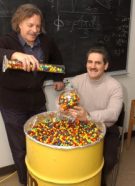A sweet advance in candy packing
Objects shaped like M&Ms can snuggle together more tightly than spheres do.
By Emily Sohn
Don’t play with your food—unless you’re doing a science experiment. Then, you might learn something surprising.
That’s what happened recently when researchers started amusing themselves with M&Ms. They found that you can cram more M&Ms into a bag than gumballs of the same size. Their lab and computer experiments showed that objects shaped like M&Ms—squashed spheres—can pack together more tightly than spherical ones can.
 |
|
Researchers Paul Chaikin (left) and Salvatore Torquato of Princeton University used M&Ms to study how objects pack together.
|
| Denise Applewhite |
Next time you’re in a grocery store, check out the oranges. Chances are the spherical fruits are stacked in the most efficient way possible. Above the first layer, each orange sits in a pocket formed by a triangle of three oranges below it. A pile of spheres arranged in this way takes up 74 percent of available space. The rest is just air.
When you pour marbles randomly into a container, though, the spheres take up just 64 percent of the space. That’s what Princeton University chemist Salvatore Torquato found in experiments he did a few years ago.
Curious to see what squashed spheres would do, Torquato and his coworkers poured M&Ms into two, differently shaped containers. To their surprise, they found that the candies took up as much as 68 percent of the space. That’s better than you can do just pouring spheres into containers.
In fact, you can do even better—73.5 percent—if you use spheres that are both squashed and stretched out (like an almond M&M). That’s almost as good as you can do by hand, stacking spheres into a perfect pile.
The researchers suspect that the squashed shape of the candies allows them to tip, turn, and settle more closely together. Their results could help scientists better understand powders and other materials made up of particles. Tighter particle packing could lead to improved heat shields for furnaces and clearer glass.
M&Ms make great test objects, Torquato says. They don’t cost much. They’re all the same size and shape. And you can eat them after the experiment is over.—E. Sohn
Going Deeper:
Weiss, Peter. 2004. Candy science: M&Ms pack more tightly than spheres. Science News 165(Feb. 14):102.
You can learn more about how M&Ms pack more tightly than spheres at www.princeton.edu/pr/news/04/q1/0212-candy.htm (Princeton University).







